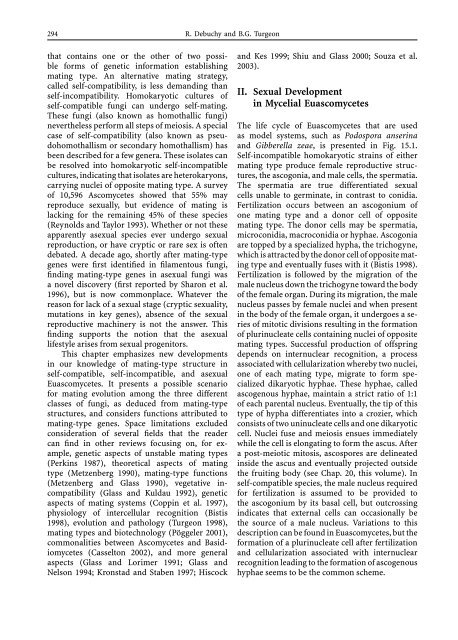Growth, Differentiation and Sexuality
Growth, Differentiation and Sexuality
Growth, Differentiation and Sexuality
You also want an ePaper? Increase the reach of your titles
YUMPU automatically turns print PDFs into web optimized ePapers that Google loves.
294 R. Debuchy <strong>and</strong> B.G. Turgeon<br />
that contains one or the other of two possible<br />
forms of genetic information establishing<br />
mating type. An alternative mating strategy,<br />
called self-compatibility, is less dem<strong>and</strong>ing than<br />
self-incompatibility. Homokaryotic cultures of<br />
self-compatible fungi can undergo self-mating.<br />
These fungi (also known as homothallic fungi)<br />
nevertheless perform all steps of meiosis. A special<br />
case of self-compatibility (also known as pseudohomothallism<br />
or secondary homothallism) has<br />
been described for a few genera. These isolates can<br />
be resolved into homokaryotic self-incompatible<br />
cultures, indicating that isolates are heterokaryons,<br />
carrying nuclei of opposite mating type. A survey<br />
of 10,596 Ascomycetes showed that 55% may<br />
reproduce sexually, but evidence of mating is<br />
lacking for the remaining 45% of these species<br />
(Reynolds <strong>and</strong> Taylor 1993). Whether or not these<br />
apparently asexual species ever undergo sexual<br />
reproduction, or have cryptic or rare sex is often<br />
debated. A decade ago, shortly after mating-type<br />
genes were first identified in filamentous fungi,<br />
finding mating-type genes in asexual fungi was<br />
a novel discovery (first reported by Sharon et al.<br />
1996), but is now commonplace. Whatever the<br />
reason for lack of a sexual stage (cryptic sexuality,<br />
mutations in key genes), absence of the sexual<br />
reproductive machinery is not the answer. This<br />
finding supports the notion that the asexual<br />
lifestyle arises from sexual progenitors.<br />
This chapter emphasizes new developments<br />
in our knowledge of mating-type structure in<br />
self-compatible, self-incompatible, <strong>and</strong> asexual<br />
Euascomycetes. It presents a possible scenario<br />
for mating evolution among the three different<br />
classes of fungi, as deduced from mating-type<br />
structures, <strong>and</strong> considers functions attributed to<br />
mating-type genes. Space limitations excluded<br />
consideration of several fields that the reader<br />
can find in other reviews focusing on, for example,<br />
genetic aspects of unstable mating types<br />
(Perkins 1987), theoretical aspects of mating<br />
type (Metzenberg 1990), mating-type functions<br />
(Metzenberg <strong>and</strong> Glass 1990), vegetative incompatibility<br />
(Glass <strong>and</strong> Kuldau 1992), genetic<br />
aspects of mating systems (Coppin et al. 1997),<br />
physiology of intercellular recognition (Bistis<br />
1998), evolution <strong>and</strong> pathology (Turgeon 1998),<br />
mating types <strong>and</strong> biotechnology (Pöggeler 2001),<br />
commonalities between Ascomycetes <strong>and</strong> Basidiomycetes<br />
(Casselton 2002), <strong>and</strong> more general<br />
aspects (Glass <strong>and</strong> Lorimer 1991; Glass <strong>and</strong><br />
Nelson 1994; Kronstad <strong>and</strong> Staben 1997; Hiscock<br />
<strong>and</strong> Kes 1999; Shiu <strong>and</strong> Glass 2000; Souza et al.<br />
2003).<br />
II. Sexual Development<br />
in Mycelial Euascomycetes<br />
The life cycle of Euascomycetes that are used<br />
as model systems, such as Podospora anserina<br />
<strong>and</strong> Gibberella zeae, is presented in Fig. 15.1.<br />
Self-incompatible homokaryotic strains of either<br />
mating type produce female reproductive structures,<br />
the ascogonia, <strong>and</strong> male cells, the spermatia.<br />
The spermatia are true differentiated sexual<br />
cells unable to germinate, in contrast to conidia.<br />
Fertilization occurs between an ascogonium of<br />
one mating type <strong>and</strong> a donor cell of opposite<br />
mating type. The donor cells may be spermatia,<br />
microconidia, macroconidia or hyphae. Ascogonia<br />
are topped by a specialized hypha, the trichogyne,<br />
which is attracted by the donor cell of opposite mating<br />
type <strong>and</strong> eventually fuses with it (Bistis 1998).<br />
Fertilization is followed by the migration of the<br />
male nucleus down the trichogyne toward the body<br />
of the female organ. During its migration, the male<br />
nucleus passes by female nuclei <strong>and</strong> when present<br />
in the body of the female organ, it undergoes a series<br />
of mitotic divisions resulting in the formation<br />
of plurinucleate cells containing nuclei of opposite<br />
mating types. Successful production of offspring<br />
depends on internuclear recognition, a process<br />
associated with cellularization whereby two nuclei,<br />
oneofeachmatingtype,migratetoformspecialized<br />
dikaryotic hyphae. These hyphae, called<br />
ascogenous hyphae, maintain a strict ratio of 1:1<br />
of each parental nucleus. Eventually, the tip of this<br />
type of hypha differentiates into a crozier, which<br />
consists of two uninucleate cells <strong>and</strong> one dikaryotic<br />
cell. Nuclei fuse <strong>and</strong> meiosis ensues immediately<br />
while the cell is elongating to form the ascus. After<br />
a post-meiotic mitosis, ascospores are delineated<br />
inside the ascus <strong>and</strong> eventually projected outside<br />
the fruiting body (see Chap. 20, this volume). In<br />
self-compatible species, the male nucleus required<br />
for fertilization is assumed to be provided to<br />
the ascogonium by its basal cell, but outcrossing<br />
indicates that external cells can occasionally be<br />
the source of a male nucleus. Variations to this<br />
description can be found in Euascomycetes, but the<br />
formation of a plurinucleate cell after fertilization<br />
<strong>and</strong> cellularization associated with internuclear<br />
recognition leading to the formation of ascogenous<br />
hyphae seems to be the common scheme.

















